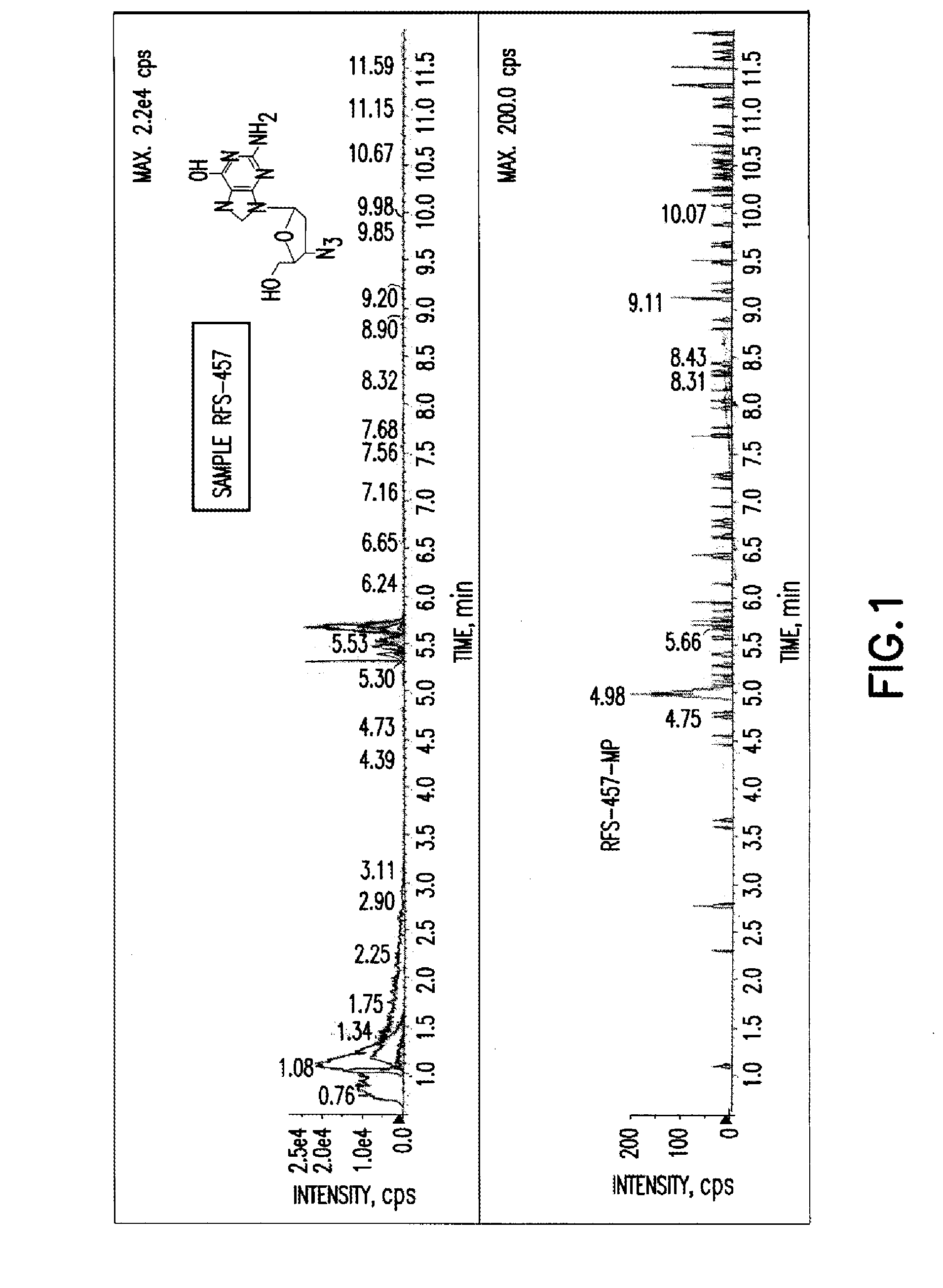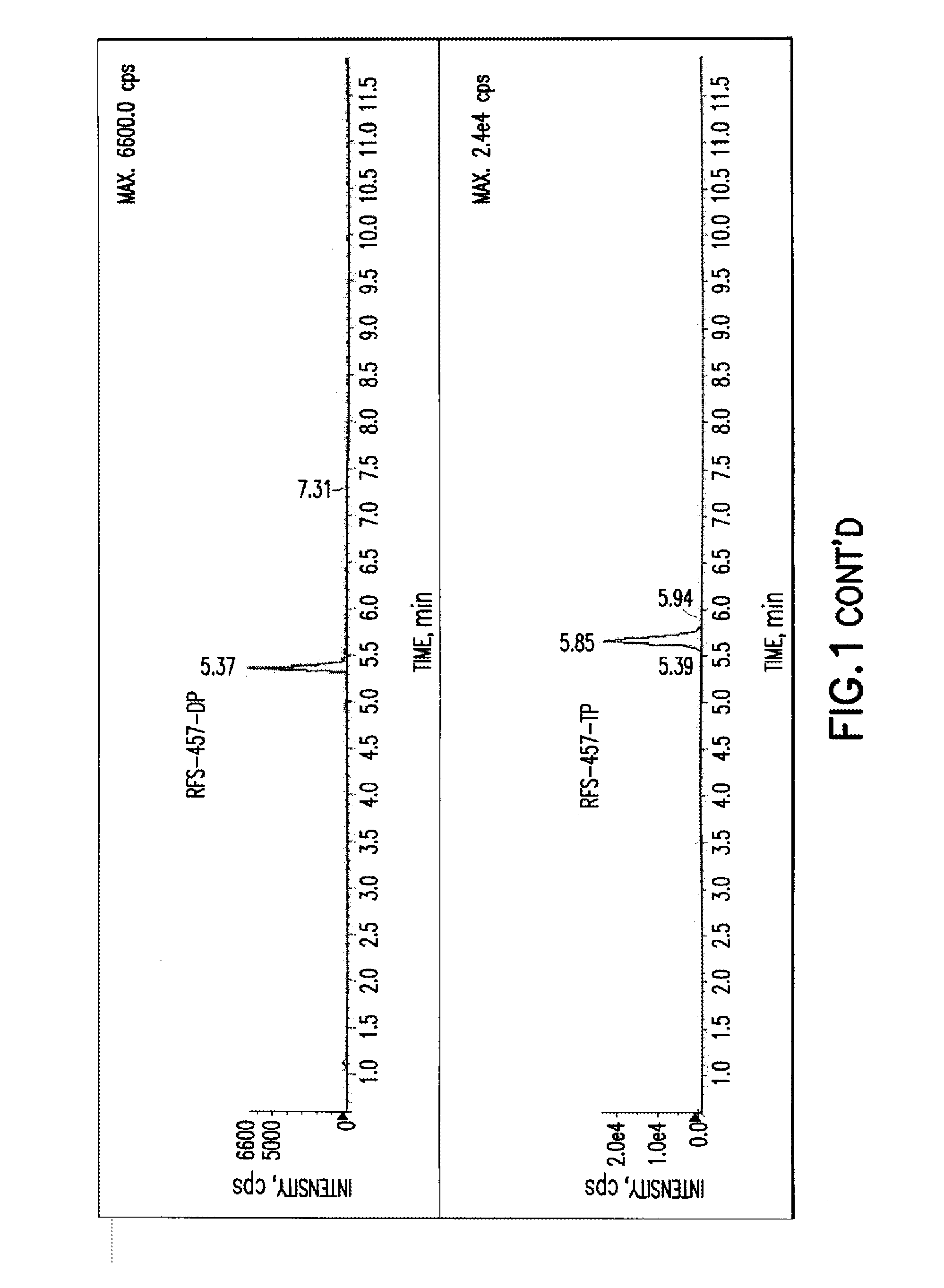Purine nucleoside monophosphate prodrugs for treatment of cancer and viral infections
a technology of purine nucleoside monophosphate and prodrugs, which is applied in the direction of biocide, organic chemistry, drug compositions, etc., can solve the problems of limiting future treatment options, significant limitations of approved nrti, and increased risk of severe side effects
- Summary
- Abstract
- Description
- Claims
- Application Information
AI Technical Summary
Benefits of technology
Problems solved by technology
Method used
Image
Examples
specific examples
[0334]Specific compounds which are representative of this invention were prepared as per the following examples and reaction sequences; the examples and the diagrams depicting the reaction sequences are offered by way of illustration, to aid in the understanding of the invention and should not be construed to limit in any way the invention set forth in the claims which follow thereafter. The present compounds can also be used as intermediates in subsequent examples to produce additional compounds of the present invention. No attempt has necessarily been made to optimize the yields obtained in any of the reactions. One skilled in the art would know how to increase such yields through routine variations in reaction times, temperatures, solvents and / or reagents.
[0335]Anhydrous solvents were purchased from Aldrich Chemical Company, Inc. (Milwaukee). Reagents were purchased from commercial sources. Unless noted otherwise, the materials used in the examples were obtained from readily avai...
example 1
(2S)-ethyl 2-((((2R,3R,4R,5R)-5-(2,6-diamino-9H-purin-9-yl)-3,4-dihydroxy-4-methyltetrahydrofuran-2-yl)methoxy)(phenoxy)phosphorylamino)propanoate (75)
[0336]To a solution of (74) (30 mg, 0.1 mmol) in THF (1 mL) and DMF (1 mL) at 0° C. was added (2R)-ethyl 2-(chloro(phenoxy)phosphorylamino)propanoate1 (0.4 mL, 0.4 mmol), then added t-BuMgCl (0.4 mL, 0.4 mmol) in portions. After stirring overnight at rt, the reaction mixture was neutralized with ammonium chloride(aq), conc, then purified by flash column chromatography with dichloromethane:methanol=7:1-7:2 to give 75 (1 mg, 1.8%).
[0337]LC / MS calcd. for C22H30N7O8P 551.1, observed: 552.1 (M+1).
REFERENCES
[0338]1. (a) Perrone, P.; Daverio, F.; Valente, R.; Rajyaguru, S.; Martin J. A.; Lévêque, V.; Pogam, S. L.; Najera, I.; Klumpp, K.; Smith, D.; B. and McGuigan, C. First Example of Phosphoramidate Approach Applied to a 4′-Substituted Purine Nucleoside (4′-Azidoadenosine): Conversion of an Inactive Nucleoside to a Submicromolar Compound ve...
example 2
(2R)-ethyl-2-((((4R)-4-(2,6-diamino-9H-purin-9-yl)-1,3-dioxolan-2-yl)methoxy)(phenoxy)phosphorylamino)propanoate (77)
[0339]To a solution of compound 76 (30 mg, 0.12 mmol) in THF (5 mL) was added 1 M solution of t-BuMgC1 (0.36 mL, 0.36 mmol) and stirred for 30 min. To the reaction mixture was added (2R)-ethyl 2-(chloro(phenoxy)phosphorylamino)propanoate (0.36 mL, 0.36 mmol) in THF at rt and was stirred overnight, neutralized with ammonium chloride(aq), conc, the crude mixture was purified by flash column chromatography with ethyl acetate:methanol=5:1 to give 77 (28 mg, 46%).
[0340]1H-NMR (CD3OD, 300 MHz) δ: 7.80-7.79 (s, 1H), 7.26-7.09 (m, 5H), 6.27 (m, 1H), 6.12 (brs, 2H), 5.25 (m, 3H), 4.47 (m, 2H), 4.22 (m, 2H), 4.03 (m, 2H), 3.83 (m, 1H), 1.33-1.15 (m, 6H).
[0341]LC / MS calcd. for C20H27N7O7P 508.2, observed: 508.3 (M+1).
PUM
 Login to View More
Login to View More Abstract
Description
Claims
Application Information
 Login to View More
Login to View More - R&D
- Intellectual Property
- Life Sciences
- Materials
- Tech Scout
- Unparalleled Data Quality
- Higher Quality Content
- 60% Fewer Hallucinations
Browse by: Latest US Patents, China's latest patents, Technical Efficacy Thesaurus, Application Domain, Technology Topic, Popular Technical Reports.
© 2025 PatSnap. All rights reserved.Legal|Privacy policy|Modern Slavery Act Transparency Statement|Sitemap|About US| Contact US: help@patsnap.com



